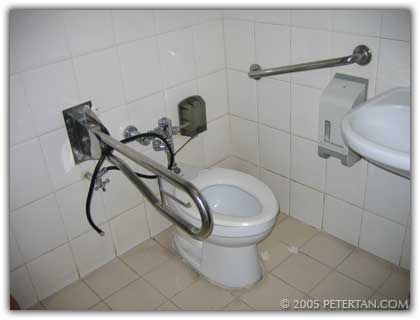
Wheelchair accessible toilet at Gleneagles Intan Medical Centre.
Photo by Wuan.
Toilets for disabled persons are basically ones that are large enough to allow the manoeuvering of a wheelchair inside. The more correct term for such facilities is accessible toilets for wheelchair users; hence they are marked with the international symbol of accessibility on the doors. The doors open out and are affixed with lever locks, bars and large latches that are can be operated by hands with poor dexterity.
Fixtures are all within easy reach and suited for use to those with limited hand function. Grab bars on both sides of the closet bowls allow for easy transfer from wheelchair and vice versa. The height for washbasins is just right for a wheelchair user to use. An alarm with cord makes it very useful when the need to summon for help arises.
The floors should be dry and clean. Hands of wheelchair users usually come in contact with tyres. Rolling over wet floors will dirty the wheels and the hands as well. Likewise the closet bowls and washbasins should be clean as hands will often come into contact with it.
There is a need for such toilets because the cubicles in normal public toilets are usually small, inaccessible and not adapted for the use of disabled persons. Washbasins in such toilets are usually placed in the common areas and not positioned for convenient use of those on wheelchairs.
There is a reason why non-disabled persons are prohibited from using such toilets. Repeated use and abuse will damage and make the toilets dirty, wet and unusable to disabled persons. For every ten to twelve usable toilets for gents and ladies, there is only one that is accessible to wheelchairs. An unusable accessible toilet will greatly inconvenience a disabled person who needs to use one urgently.
Many people with disabilities have poor or no control over their bowels and bladders. Some disabled persons suffer from chronic kidney failure and need use the toilets to perform intermittent catheterisation, failing which the kidneys will be further damaged or infection sets in. This is another reason why these toilets must be left vacant for such contingencies because they are the only handful that is accessible to wheelchairs at any one place.
In the United Kingdom, the Royal Association for Disability and Rehabilitation (RADAR) implemented the “National Key Scheme” that allows access to locked accessible toilets. These locked toilets can be accessed with a RADAR key that can be purchased by those who qualify.
The National Key Scheme, sometimes known as the RADAR Scheme, was developed because some public toilets designed for disabled people had to be locked to prevent damage and misuse. This has been countered by their being locked separately from other toilets. The NKS aims to provide disabled key holders with independent access to the toilets provided for them and increase the likelihood of the facilities being in a useable state.
If accessible toilets for disabled people do have to be locked, providers are asked to join the NKS, which involves fitting standard locks to their toilets and making keys available to disabled people. Over 400 local authorities in all parts of the country have now adopted the scheme.
In addition to public conveniences, toilets for disabled people provided by a wide range of other public, voluntary and commercial organisations have been fitted with the NKS lock. So it can now be found in shopping centres, country parks, railway and bus stations, bars, motorway service areas and sports venues. Around 7000 toilets are now fitted with the lock and can be found from Shetland to Jersey and Derry to Dover.
Within the scheme RADAR:
- supplies NKS keys to disabled people who cannot, or have difficulty, getting one locally,
- maintains a list of toilets fitted with the NKS lock
- and provides general information about the scheme to individuals and providers.
RADAR does not advocate the general fitting of locks to all toilets for disabled people but does urge that the NKS is used where a lock is required.
Link: National Key Scheme
In Kuala Lumpur, two major shopping complexes have locked their wheelchair accessible toilets for the same reasons. Suria KLCC and Berjaya Times Square have implemented a similar system. The janitors hold the keys and control access into the toilets. These two complexes have some of the cleanest accessible toilets I have used.
Toilets for disabled persons is a right, not a privilege. A barrier free environment provides people with disabilities a better quality of life by allowing them to participate and be contributing members of society. To deprive people with disabilities these basic amenities is to infringe on their rights and dignity. Whither civil society when selfishness reigns and the needs of people with disabilities are disregarded and ignored?
Related articles:
Accessibility for the Disabled – A Design Manual for a Barrier Free Environment
The Standard Rules on the Equalization of Opportunities for Persons with Disabilities

Comments are closed.